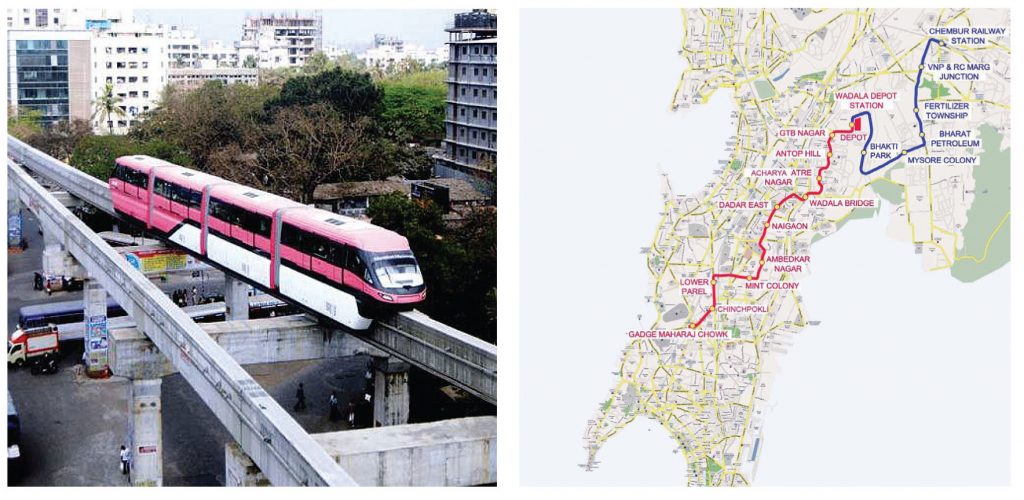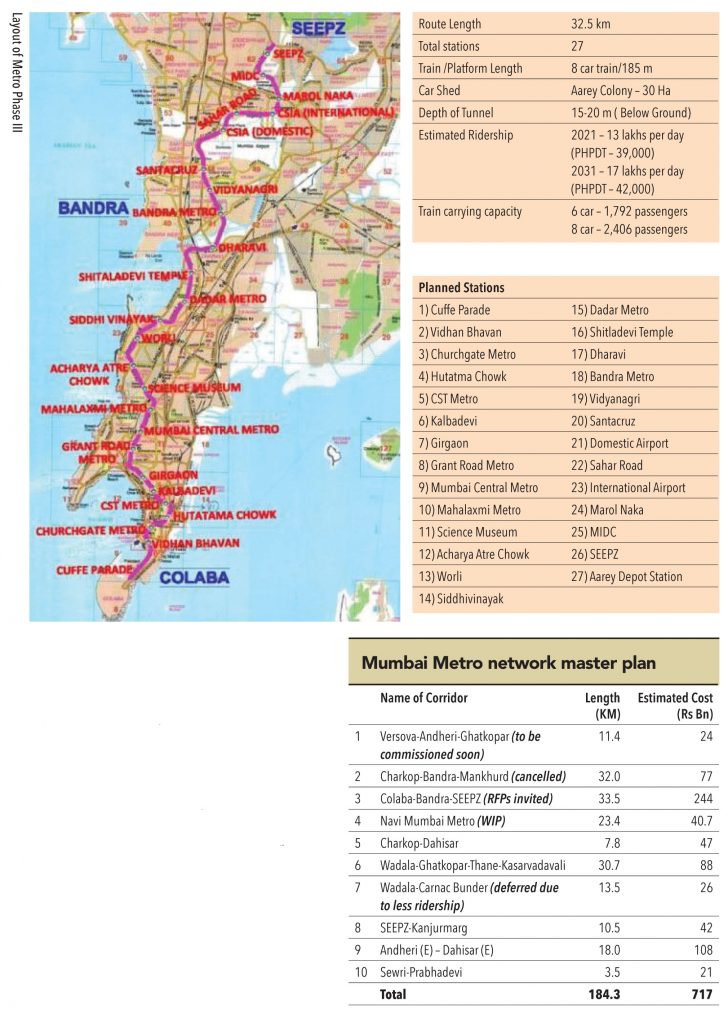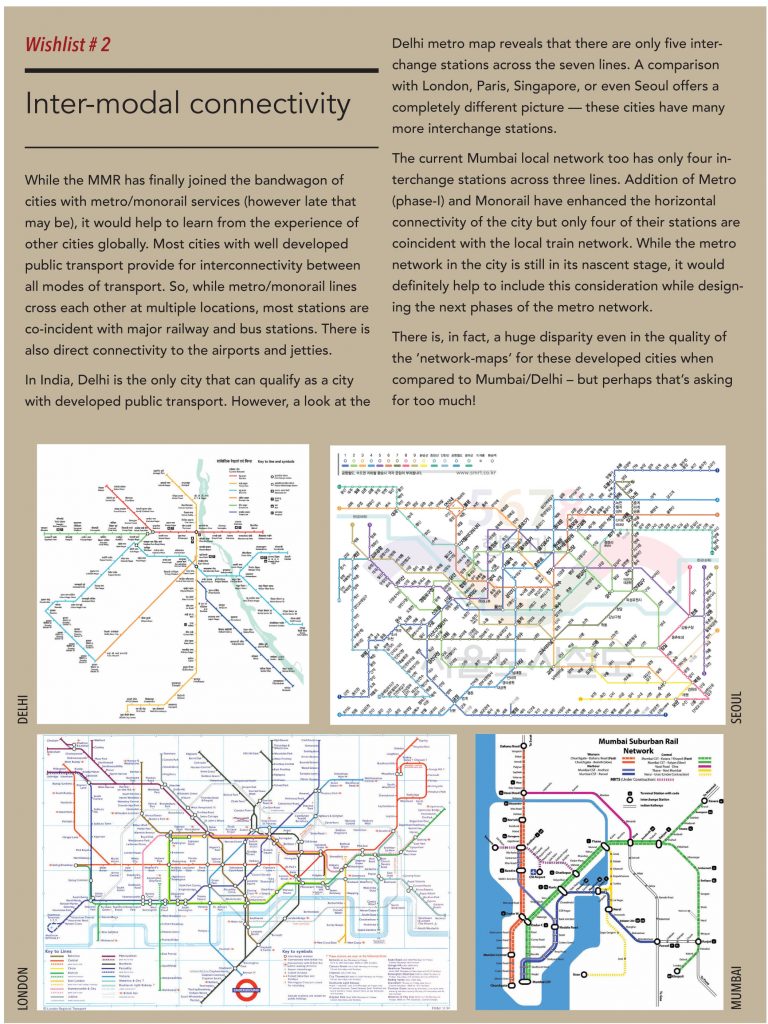1.Monorail – Phase 1
While Mumbai should have been one of the first cities in the country to start a metro service (given the paucity of land for building roads), it has been a laggard amongst all Indian metros. Forget Delhi, even Bengaluru started its metro in October 2013. MMR finally got its first metro/monorail service in December 2013, when the first phase of Mumbai monorail was thrown open to the public. Constructed by L&T, the monorail currently connects Chembur and Wadala and intends to extend the connectivity to Mahalaxmi (the beginning of South Mumbai) in the second phase. It is expected to reduce the travel time between Chembur and Wadala from 40 minutes to 20 minutes. The project has seen tremendous response since it became operational and the traffic is only expected to grow hereafter.
While everyone has lauded the effort invested in making monorail a success, many have questioned the wisdom of connecting a sparsely populated suburb (Wadala) at the cost of ignoring suburbs that would have actually benefitted more from a similar service.
While everyone has lauded the effort invested in making monorail a success, many have questioned the wisdom of connecting a sparsely populated suburb (Wadala) at the cost of ignoring suburbs that would have actually benefitted more from a similar service.

Reporter’s Diary: We boarded the monorail from the Chembur station. While the station was well built and had a swanky feeling to it, the basic necessities like toilet and drinking water were missing.The ride was pleasant but not the smoothest one, and there were times when the train lurched and shook – the turn at Bhakti Park station was particularly nasty. The view of the city from inside the train was quite unique – it veered form green pastures (Chembur golf course) to slums (innumerable).It took us exact 21 minutes to reach Wadala depot station – a far cry from atleast 40-50 minutes that it would have taken otherwise. But the best was saved for the last – the Wadala depot station is literally in no-man’s land, and has no bus/taxi services even to Wadala, which, by the way, is few kilometres away!


Metro – Phase I
The wait is finally nearing its end, and we should expect the first metro services in MMR to be thrown open to public anytime now. The much delayed project (being built by a Reliance Infrastructure-led consortium on a PPP basis) has received all security and operational clearances and is awaiting the final tariff order.
The service is expected to significantly decongest the suburb of Andheri and provide connectivity between western suburb of Varsova to eastern suburb of Ghatkopar. The 11-kms-long service line will have 12 stations at equal intervals, implying all travellers will find stations every half kilometre from wherever they are on the line. It is expected to reduce travel time between the two ends from the current 90 minutes to 21 minutes.
Even though the project is much delayed, the construction of the Mumbai Metro can be hailed as an engineering marvel — the track was laid through one of the most densely populated suburbs of the city (Andheri and Ghatkopar). The company had to delpoy ‘form traveller’ to build the viaduct above the western express highway flyover at Andheri (another example of poor and myopic planning).
While the residents are excited about the Metro and the time-saving it will bring, they also fear that inadequate parking and ‘apron’ space at all stations will increase congestion and actually increase traffic snarls on the road beneath. For once, MMRDA has already considered this and plans to implement a ‘Station Area Traffic Improvement Plan’. How well it will work remains to be seen.
Metro – Phase-3 (Colaba – Bandra – SEEPZ)
While the second phase of metro has been cancelled due to disagreement between MMRDA and the chosen vendor (Reliance Infrastructure), work on phase-3 is already in progress. Metro phase-3 route will be 32.5 kms long and fully underground with 27 stations. It will connect the major business districts (Nariman point and Bandra-Kurla Complex),domestic and international airports, and the industrial areas of MIDC and SEEPZ. It will also serve to connect various areas in the island city that are not served by suburban railways (Kalbadevi,Worli, Prabhadevi, airport, and Andheri East)).
The project is funded by Japan International Co-operation Agency (JICA) who will provide loan assistance to the tune of Rs 132.35bn and the rest of the expenditure will be made by the government of India, government of Maharashtra, and MMRDA in the form of equity, subordinate debt, and funds from MIAL (Mumbai International Airport Ltd).
Project status
• The central cabinet approved the project on 27th June 2013
• Loan agreement was signed by JICA on 17th Sept 2013
• The project was notified under Metro Act by MoUD on 18th Sept 2013
• The process for appointing General Consultant (GC) and Pre Qualification of contractor for civil works is in progress.
• RFPs have already been invited, and the bidding process is expected start by June 2014.
4.Other planned metros
Overall, MMRDA has highly ambitious plans for the Metro network in the city. There are nine phases which have been proposed, running for a cumulative length of 184kms and entailing expenditure to the tune of Rs 717bn. While phase I is already complete, phase II has been shelved. Phase III and the Navi-Mumbai Metro are already in development stage.


Subscribe to enjoy uninterrupted access